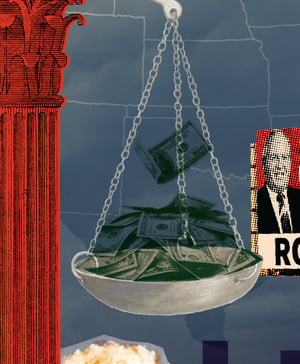
Are We Witnessing the Next “Claims Crisis”?
The National Practitioner Data Bank publishes claims payouts in increments, capping out at >$2 million. In the not-so-distant past, a one or two million dollar claim was considered a shock verdict. In today’s claims environment, you’ll see a news story for a claim well over that amount once a week.
Additionally, states from coast to coast are putting forward tort reform initiatives—increasing damage caps, loosening legislation regarding who can bring forth a claim, and expanding where claims can be filed.
And, of course, there is the fact that claims have been lingering for much longer than usual—waiting in the backlog as courts struggle to get back on track after closing during the pandemic.
It’s an adventurous time to be defending medical malpractice claims, to put it mildly. But, as we are fond of saying around here, the good news for ProAssurance (and our agency partners) is we have the right people for the job.
The ProAssurance healthcare liability claims team has decades of combined claims experience on a nationwide scale. There is very little they have not experienced firsthand in the courtroom. Their vigilance on behalf of our insureds is essential.
In this issue, we will begin with a look at some overarching trends that are affecting the claims environment on a nationwide scale. We will also look into specific hot button issues in key states that are having a significant impact on the claims environment in that area—or have the potential to have a more far-reaching effect.

2022-2023 Shock Verdicts
MPL carriers and their insureds are facing an environment in which large verdicts are too commonly rendered without regard to the facts of the case regarding liability or a reasonable assessment of damages. 2023 has continued the record-setting pace of excess verdicts across the MPL industry.

Jury Anchoring in Medical Liability Trials
Anchoring is a form of cognitive bias in which a person relies too heavily on the first piece of information they receive and use it to direct future decision-making. It’s an effect that’s very durable and difficult to overcome.1 It’s used in many ways from influencing retail purchases to influencing damage awards in civil courts.
One common example of anchoring is when a retailer lists a manufacturer’s suggested retail price (MSRP) of an item as, say, $99 but offers it at the “steep discount” of $40. The inflated MSRP is our reference point for decision-making so $40 seems like a great price.2
While this is a simple and relatively harmless example to illustrate the concept of anchoring bias, anchoring can have serious real-world consequences in a medical malpractice suit when used as a plaintiff tactic to influence a jury to higher awards.
One prominent example of jury anchoring is seen in District of Columbia v. Colston, where plaintiff counsel argued to the jury in closing arguments, “How much is an eye worth? How much is a healthy eye worth? You cannot restore his vision but you can compensate him for the loss. Is an eye worth five hundred thousand? Eight hundred thousand? A million? That is for you to say.” On appeal, the court recognized it would be improper based on case law precedent “for counsel to suggest to the jury that it award a specified dollar amount” but also noted while counsel did mention specific dollar amounts in his argument, his statements were not improper. Instead, the court ruled that “although some of the language he used is similar to that condemned in Delaware Olds, supra, we find that it was not used in the manner condemned in Delaware Olds.”
Even when plaintiff counsel does not directly ask for a certain amount, according to ProAssurance Claims Executive Mark Lightfoot, anchoring may still achieve the desired effect. In addition to being just an indirect way of asking for a number, in the above case the first dollar figure mentioned by plaintiff counsel was $500,000. The jury awarded the plaintiff $400,000.
Social science studies also show that jury anchoring is effective. In one study of this phenomena, the researchers found that “both monetary and causal anchors systematically influenced judgments of the probability that the defendant caused the plaintiff's injuries, compensation awarded, and perceptions of the litigants [and] these anchoring effects are unlikely to be explained by either demand effects or perceived relevance of the anchor.”3 Another study concluded that “large lump sum demands have a strong anchoring effect on damages awards.”4 Still another study found that—generally—the anchoring effect is present even when the anchor figures are random.5
Since most jurors “are often at a loss when it comes to determining what constitutes fair and reasonable noneconomic damages,” they use the figures given by counsel (usually plaintiff counsel) and news reports of nuclear verdicts as their starting point.6 Additionally, with nuclear verdicts growing in size and frequency, lawyer advertisements of nuclear verdicts provide additional anchors for juries to use as their starting point for determining damage awards.7
References:
1 Kendra Cherry. “Anchoring Bias: What It Is and How to Prevent It.” Explore Psychology. January 22, 2022.
2 Andrea J. Caceres-Santamaria. “The Anchoring Effect.” Page One Economics. Federal Reserve Bank of St. Louis. April 2021.
3 Gretchen B. Chapman and Brian H. Bornstein. “The More You Ask For, the More You Get: Anchoring in Personal Injury Verdicts.” Applied Cognitive Psychology, 10(6), 519–540. 1996. DOI: /10.1002/(SICI)1099-0720(199612)10:6<519::AID-ACP417>3.0.CO;2-5
4 John Campbell, Bernard Chao, and Christopher Robertson. “Time is Money: An Empirical Assessment of NonEconomic Damages Arguments.” Washington University Law Review. 95 WASH. U. L. REV. 01 (2017).
To counter this effect, some are arguing that defense teams consider suggesting a smaller, more reasonable figure for the jury to consider if the jury finds for the plaintiff. The argument for lowering the anchor is that, without it, the plaintiff’s number is the sole figure for jurors to consider. Providing a lower defense figure also gives jurors favoring the defense their own anchor for arguing down the award.6 Countering the anchoring effect in settlement negotiations is another opportunity to lower an award by offering a realistically low figure first before plaintiff counsel sets their high anchor.5
Not all defense counsel are comfortable with these counter-anchoring strategies. In the experience of ProAssurance Regional Claims Vice President Laura Ekery, the traditional thinking is that a defendant’s number “either implies an admission of negligence or it sets a floor, leading to the jury awarding at least that much, or more.”
Despite these reservations, Ekery believes there may be some value in arguing an alternate point of view on what constitutes reasonable compensation: “This is most appropriate when a plaintiff is overreaching. A defense should include evidence as to how and why the plaintiff’s damage model is excessive. Attacks on a plaintiff’s proposed compensation may be less off-putting when a defendant proposes a reasonable alternative.” There is also evidence that these strategies can not only mitigate the size of verdicts but may impact a jury’s assessment of liability.6
References:
5 Weber Advising “Understanding Anchoring.” Undated article.
6 Christina Marinakis. “How to Counteract the Anchoring Effects of a Plaintiff’s Damages Request.” May 5, 2022. National Law Review. Volume XII, Number 125.
7 U.S. Chamber of Commerce Institute for Legal Reform. Nuclear Verdicts: Trends, Causes, and Solutions. September 2022. [PDF]

Pennsylvania Medical Malpractice Venue Ruling Could Spell Financial Trouble

The Pennsylvania Supreme Court’s reversal of a key 20-year-old Medical Care Availability and Reduction of Error Act (MCARE) reform went into effect in January 2023 and returns medical malpractice venue rules to those in effect before the reform.1 Supporters of the change cite the need to restore justice and “level the playing field,”1 while critics fear a return to an environment that fueled the medical liability crisis of the late 1990s and early 2000s—larger jury awards and a significant increase in liability insurance rates for providers in an already fragile healthcare system.1
Prior to the passage of MCARE in 2002, Pennsylvania Supreme Court Rules of Civil Procedure allowed broad flexibility in where medical malpractice claims could be filed. This led to what is known as venue shopping, where litigants could select a permissible venue where they anticipated friendly juries and larger awards.2 Healthcare providers blamed this environment for an exodus of physicians from the state—especially those in higher risk (and thus higher premium) specialties—to more favorable practice environments.3
An investigation by the Pennsylvania legislature in response to the crisis resulted in MCARE, which included, among other features, changes to venue rules requiring medical professional liability claims to be filed in the county in which the cause of action arose.2 The contention around the issue continued among the public as well as within the elected Supreme Court, which has state constitutional power “to prescribe general rules governing practice, procedure, and the conduct of all courts.”
Critics of MCARE argued that juries in conservative and rural counties were less friendly to medical malpractice claims resulting in an unfair advantage to medical professionals in those areas. They also claimed that in smaller counties physicians were more well-known and respected and treated more sympathetically. These demographic conditions, they argued, led to lower awards for plaintiffs.2
In 2018, the Pennsylvania Supreme Court’s Civil Procedural Rules Committee published a proposed amendment to the rule claiming that it unfairly privileged a particular class of defendants, resulting in a significant decrease in medical malpractice claims.2 An actuarial analysis commissioned by the Pennsylvania Senate Judiciary Committee prior to the Court’s decision assessed the impact of the change and identified a number of likely negative impacts. "The analysis concluded that medical professional liability insurance carriers, specifically, are likely to see a significant rise in lawsuits filed in venues like Philadelphia where juries are seen as 'more sympathetic to patients and [more likely to] award larger verdicts.'”4 Exacerbating the impact of this change, according to the analysis, are existing trends in healthcare consolidation and telehealth—both of which increase the geographic reach of urban-based health systems and (theoretically) the number of permissible venues available to litigants.2,4 Ultimately the Rules Committee concluded that there was no justification for treating medical malpractice differently than other civil claims.1
As happened before the MCARE reforms, larger verdicts are likely to contribute to an increase in costs of medical liability insurance for providers resulting from higher claims costs for carriers.4 The actuarial analysis estimated increased cost of physician claims between 4.9% and 7.2% statewide, with the projected cost increases much higher in some counties; for example, in Lancaster County (41.0%-82.0%), Montgomery County (49.2%), and Venango County (13.9%-27.8%). These estimates may even be understated if the plaintiff’s bar is successful in bringing cases in favorable venues where a health system has only a negligible attachment.4
An additional worry, according to ProAssurance Claims Director John Zdanowicz, is that a substantial increase in claims filed in favorable plaintiff venues could result in backlogs in those courts, which could extend the life of all claims. This could both delay resolution of a litigant’s case and result in carriers incurring additional allocated loss adjustment expenses (ALAE) to service cases over an extended period of time, adding to the increased costs already resulting from the larger awards. These additional costs could result in increased premiums for providers.
In August 2022, the Pennsylvania Supreme Court accepted their Civil Procedural Rules Committee’s recommendations and reversed the two-decades-old MCARE venue rule effective January 2023. There are still restrictions on where a litigant can file, but the permissible venues have broadened significantly based on the recission of the rule.
While it is too early to assess the long-term effects of the change, the market is already seeing an impact. According to court data, Philadelphia’s Court of Common Pleas has seen nearly triple the number of medical malpractice cases in January and February of 2023 compared to the same period in 2022, and the highest number of cases filed in these two months since 2017.5
References:
- Angela Couloumbis and Stephen Caruso. “Major Shift in Medical Malpractice Rules in Pa. Could Help Victims, but Opponents Fear the Cost.” Spotlight PA. August 25, 2022.
- Kandace Watkins. “Pennsylvania Supreme Court Reverses 20-Year Venue Rule.” Expert institute. Updated September 13, 2022.
- Peter Hall. “Dire Predictions Follow Pa. Supreme Court’s Loosening of Medical Malpractice Filing Rules.” Pennsylvania Capital-Star. October 20, 2022.
- Actuarial Review of the Proposed Amendment to the Medical Professional Liability Venue Rule. Report prepared for the Commonwealth of Pennsylvania Senate Judiciary Committee. June 9, 2022.
- Jason Laughlin and Abraham Gutman. “Philly’s Medical Malpractice Cases Are Surging Since a New State Rule Went Into Effect.” Philadelphia Inquirer. March 8, 2023.

MICRA in California
Insights from Gina Harris, Claims Executive, West Region
California’s Medical Injury Compensation Reform Act (MICRA) was enacted in September 1975. The act stood for nearly 50 years with noneconomic (pain and suffering) damages in the state being capped at $250,000. In 2022, California state legislators moved to re-evaluate and update MICRA’s provisions to reflect the rising rates of inflation. Gina Harris, Regional Claims Executive for the West region, said, “In 2014, the people of California voted down a similar ballot initiative by a 2 to 1 margin because it was explained that raising these damage numbers could really limit their access to healthcare and increase healthcare costs. There was also the potential that doctors would not necessarily come to California for their medical education.” Physicians often stay in the places where they perform their residencies and fellowships because they establish a patient base and start lives there. However, in 2022, there was no ballot initiative giving voters a chance to weigh in. Both the legislature and major healthcare groups negotiated a compromised resolution that was eventually signed by the governor in May 2022. The new legislation took effect on January 1, 2023.
The MICRA revisions raise the cap on the noneconomic damages that may be awarded to a plaintiff if they win their case. For wrongful death suits, the cap was raised to $500,000 with incremental increases of $50,000 over the next decade, ultimately reaching $1M. In malpractice suits that do not involve wrongful death, the cap was raised to $350,000 with incremental raises of $40,000 over the next decade, ultimately reaching $750,000. After the 10 years have passed, both caps will have a 2.0% adjustment each year to take inflation into account. However, there are areas of the law that are not as clear. The new legislation creates three separate categories of defendants with the potential for three separate caps. The first category is for affiliated healthcare providers, and the second one is for affiliated facilities like hospitals. Then there is a third category for unaffiliated healthcare providers or healthcare institutions. “One could safely assume ambulance companies fall into that bucket, but what else?” mused Harris. She explained this is an example of what should be clarified in the law adding, “There’s a real gray area, and it can get muddy very fast.”
The act amending MICRA went into effect on January 1, and Harris said, “We were expecting a ton of new cases to be filed because that’s what we were being told by plaintiff attorneys.” ProAssurance claims professionals were expecting to see the first quarter filled with new lawsuits due to the increased caps and potential for larger verdicts and settlements. However, that has not been the reality. “What we’ve seen are a lot of Notices of Intent to Sue,” said Harris. “With these filings, the plaintiff may be allowed up to an extra 90 days added to the statute of limitations. So we’ve seen a lot of these extensions on these cases, but suits aren’t being filed.” A possible reason for the delay is the aforementioned “gray area.” Due to cost and time, plaintiff attorneys may be hesitant to tackle issues that could result in appeals to clarify the ambiguous areas of legislation. However, since caps on wrongful death cases immediately increased from $250,000 to $500,000, we anticipated seeing many more of those claims, but that isn’t what we are experiencing yet.
Of the states in the West region, Nevada is the only one that has been following California’s example. Nevada state legislators are debating a bill that would increase the pain and suffering cap from $350,000 to $2.5M and remove other significant protections for all healthcare providers. It is an incredibly dangerous proposition for a fast-growing state that already lacks qualified doctors, nurses, and facilities. Other than Nevada, the states in the West are staying with their existing standards regarding caps for the time being. We anticipate knowing Nevada’s final decision in June.
We’ve got this under control. This isn’t our first rodeo; we’ve experienced this in other states and know how to navigate the changes in tort reform. ProAssurance has been doing business across the country for decades. According to Harris, we have seen the pendulum swing radically in one direction and then come back to a more moderate position after experiencing the impact of such harsh legislation. At ProAssurance, we will adjust accordingly. “These damage cap increases are predictable,” said Harris. “You have a good idea of what you’re going to get over time, and premiums can be increased commensurate with climate and risk.” She elaborated that ProAssurance’s experienced claims representatives will continue to analyze cases and reserve appropriately based on the facts of each individual situation. Harris emphasizes, “We’re good at this; this is what we do, and we have an incredibly talented staff who do this well.”
Reference:
Tanya Albert, Henry. “California's MICRA Law Modernized after Nearly 50 Years.” American Medical Association, June 7, 2022.

House File 161 Establishes Noneconomic Damages Caps

On February 16, 2023, Iowa Governor Kim Reynolds signed House File 161 into law. This bill establishes caps for noneconomic damages awarded to plaintiffs in certain severe medical malpractice cases. The legislation, passed by the House (54-46) and Senate (29-20), limits the amount of money certain injured claimants can receive for pain and suffering as well as emotional distress, with damages capped at $1 million for lawsuits naming clinics, individual physicians, and other healthcare providers and $2 million for lawsuits against hospitals. The cap applies to any “cause of action” accruing on or after the effective date, i.e., the day the bill was signed and enacted, and is not dependent on when a lawsuit is filed. For causes of action accrued before the enactment, the old law will apply, meaning there will continue to be no cap on noneconomic damages for the delineated severe medical malpractice cases. HF 161 does not impose any caps on economic or punitive damage amounts or money awarded for financial losses. In fact, while Iowa Code section 668A.1 previously restricted claimants to receive no more than 25% of punitive damages with 75% going to a state trust fund, HF 161 amended the Code to provide full recovery of those damages in cases against physicians, surgeons, and other healthcare providers whose conduct is determined to constitute “willful and wanton disregard for the rights or safety of another.”
HF 161 modifies Iowa Code section 147.136A, a statute established by the legislature in 2017, which imposes noneconomic damage caps at $250,000 in medical malpractice suits against healthcare providers. This statute allowed an exception in cases of “substantial or permanent loss or impairment of a bodily function, substantial disfigurement, or death,” enabling juries and courts to award higher damages to plaintiffs, with no limit, if the $250,000 compensation was deemed inadequate. HF 161 states that recovery amounts for such severe medical malpractice cases shall not exceed the new $1 million or $2 million cap and adds “loss of pregnancy” to the list of qualifying medical incidents. The bill also leaves the current definition of noneconomic damages intact (“damages arising from pain, suffering, inconvenience, physical impairment, mental anguish, emotional pain and suffering, loss of chance, loss of consortium, or any other nonpecuniary damages”), but adds a clarification that “loss of dependent care” is an economic damage. The noneconomic damage caps will increase 2.1% beginning January 1, 2028, then annually each January 1 thereafter. HF 161 will also establish a task force to create recommendations for the reduction of medical error rates in Iowa.
Supporters of the bill, including Reynolds, say these caps will help make Iowa a more attractive place for qualified physicians to practice but will also improve access to quality healthcare for all Iowans. “Over the years I’ve heard from many hospital executives about the challenges they face when recruiting doctors,” Reynolds said. To her, the bill represents reasonable malpractice reform and serves as “a lifeline for rural medical providers facing rising insurance rates and difficulty attracting doctors wary of large jury verdicts.” She emphasizes that liability limits help hospitals, particularly those in underserved rural areas and with care shortages, control their costs and enable them to remain open.
Those who opposed HF 161, including most Democrats and several Republicans, argued against the appropriateness of lawmakers placing such a limit on the pain and suffering of a person. Rep. Mark Cisneros (R-Muscatine) concurred, addressing colleagues: “Will you seriously allow yourselves to be bullied into bending your moral compass away from the people of Iowa?” Senator Nate Boulton (D-Des Moines) argued the limits would continue to victimize those already suffering the outcomes of medical malpractice incidents and that the bill does nothing to improve patient safety or prevention of these incidents. Rep. Brian Lohse (R-Bondurant) noted that a higher limit for hospitals would also encourage plaintiffs to name hospitals in their lawsuits whenever possible. Some Republicans argued the previous limits were too low, while others felt that juries should decide awards on an individual, case-by-case basis, guided by evidence. Supporters agree the bill is not about putting a value on human life, but it is about patient access, that jury awards would mean little if there were no hospitals open to provide healthcare. “As legislators we are tasked with making a public policy decision to balance the need to compensate people for medical injuries with the need to keep our healthcare industry stable and intact,” said Rep. Ann Meyer (R-Fort Dodge). “[T]here are 3.2 million Iowans who deserve care.”
Iowa is among many U.S. states currently imposing medical malpractice damage caps. It also has the fifth lowest medical malpractice insurance rates in the nation across all specialties, according to the Medical Liability Monitor. Discussions around Iowa legislation, however, did coincide with several medical malpractice lawsuits emerging from 2018 to 2022 that resulted in sizable plaintiff verdicts, including a Polk County case totaling $27 million in damages and a high-profile lawsuit against a Johnson County hospital resulting in $97.4 million in economic damages for the family of a baby who suffered severe brain injuries during birth. “Iowa’s record of medical malpractice cases was widely known and the biggest barrier in getting new physicians to practice in our state,” Reynolds says.
ProAssurance’s Midwest team continues to monitor the claims environment in Iowa. We will continue to share timely updates on any developments or changes regarding this legislation.

Grieving Families Act
In January of this year, New York Governor Kathy Hochul vetoed the state’s Grieving Families Act (A.6770/S.74-A)—a bill that would have allowed close family members to recover damages for pain and suffering after the wrongful death of a loved one.
Advocates of the bill argue that the existing wrongful death statute, which only offers compensation for income lost and expenses incurred, is unfair and denies justice for low-income communities, people of color, women, seniors, children, and persons with disabilities. They hope to see the law amended, citing overwhelming bipartisan support and emphasizing that using wages alone as a measure to determine damage amounts is unfair. The New York State Trial Lawyers Association said in a statement that Hochul “has sided with insurance companies, the healthcare industry, big corporations, and anyone else who doesn’t want to be held accountable for the negligent killing of a person.”
If it had become law, the Grieving Families Act would apply to all pending and future claims and would have expanded the existing wrongful death statute in three ways:
1. By damage type – allowing recovery for noneconomic damages such as grief and loss of consortium
2. By claimant type – changing who may receive compensation from the beneficiaries of the decedent’s will to “close family members” including step-parents and domestic partners (qualification determined by finder of fact)
3. Statute of limitations – increasing from 2 years to 3.5 years
While the governor indicated her support for the goals of the bill, she also expressed concern its expanse would have negative impacts on New York’s healthcare sector, including a significant rise in health insurance premiums, rates which already top every other state in the country. New York’s Medical Society did predict a rate hike for medical malpractice insurance of over 40% as a result of the bill. Physicians and healthcare systems struggling to make these premiums, particularly in underserved communities, would remain at a disadvantage.
The legislature passed the Act by a veto-proof majority, after which the bill was delivered to the governor for review. Hochul then proposed changes to narrow its scope, stating the above undesirable effects. According to local counsel, she presented a compromise in which the bill would not retroactively apply to pending claims and would limit claimants to parents of the deceased. It would also limit the applicability of the new laws to general liability cases only, exempting costly medical malpractice cases. These proposals were rejected, resulting in Hochul vetoing the bill. The veto has garnered support from the Greater New York Hospital Association, which represents more than 160 health systems and hospitals. “Many safety net hospitals already can’t afford malpractice insurance,” the association stated, maintaining that the bill would have brought their hospitals “to financial brink.”
While the legislature could have chosen to override the veto, it has not indicated an intention to do so. It was thought that an iteration of the Grieving Families Act might be included in the 2023-2024 budget discussions, but no related legislation was incorporated. It is expected that the issue will eventually be revisited and passed in some form.

Claims Concerns in the Southeast

If you live in (or travel to) the Southeast, you know summer is a precarious time. We are ever so mindful of the weather and potential for hurricanes. How warm are the winds coming off the Sahara? Is this an El Nino or La Nina year … and which is better? And, oh, do we love the spaghetti maps. Decision points, like when the tropical storm is in the Caribbean, will it go into the Gulf, will it go up the Atlantic coast, or will it split Florida in half … again!
Bad weather is not the only danger that looms in the Southeast. We, in the medical professional liability space, must also face the challenges and potential storms that result from litigation against our insureds. After all, that is why ProAssurance Claims is here—to protect others.
Our role is to provide exceptional management of our insureds’ claims. We strive to protect our insureds by retaining excellent defense counsel who will work diligently to defend the healthcare provider. We also make sure we locate and provide experts in the involved medical fields to review the medicine and support or insureds’ care and treatment. We evaluate and analyze the strength of defending the case and whether trial is the best option. We also work with our insureds to make them comfortable with the entire litigation process, including providing someone
for them to talk to regarding the stress related to litigation, if necessary.
So what sets ProAssurance apart from other MPL carriers? Sometimes it is the intangibles that really differentiate one from another. In a recent Company address, Ned Rand, President and CEO, spoke about “the why of what we do.” This resonated deeply in me.
The "why" is not something that can be taught, not something that is learned. The “why” is an ingrained, internally developed experience that provides a mindset that what we do matters. That is because what our insureds do matters to us, but more importantly it matters to our insureds. Most of us have a positive “story” related to interaction with a physician, nurse, or other healthcare provider. Some of us have been in the unfortunate situation to personally see our healthcare providers be faced with something that we would describe as a crisis, but which they may simply have seen as a medical challenge. As Ned commented, seeing “how healthcare providers respond with confidence and without fear to the unexpected” is why we do what we do.
Most of us have “our story” and I have mine. And it is because of the efforts, knowledge, and confidence of our delivery team that allowed my wife and me to have and share one week—seven days—with our first daughter that we otherwise would not have had that gives me the passion to work to protect the interests of our insureds.
And mine is one of many “stories” of the individuals that make up the Claims team that work every day “to allow our insureds’ to respond without delay and without fear.”
So no matter what the future holds for the Southeast region, or for the rest of the country, we will be here, at the ready. Because what we do matters.
|
|
Frank Bishop | Claims Executive, Southeast Region |

Litigation Funding at a Glance
Sometimes called settlement loans, lawsuit loans, lawsuit funding, or plaintiff funding, the litigation funding industry began in the late 1990s and is now a $2.3 billion industry. Here is a high-level look at this industry:
- A largely unregulated industry
- A funder advances money at interest to a plaintiff against the proceeds of the lawsuit
- Provides funding to plaintiffs with immediate financial needs (e.g., unable to work or out-of-pocket medical bills)
- Repayment and interest on the advance comes directly from any award in the case
- Repayment obligated only if the lawsuit is successful; lender usually can’t recoup funding if the plaintiff loses the suit (i.e., a non-recourse loan) depending on relevant law and contract terms
- Non-recourse status makes it a speculative investment:
- Often comes with very high interest rates
- Generally falls outside state usury laws due to structure
- Depending on the terms, the loan can cause plaintiff’s to lose much or all of any settlement or jury award
Reference:
Paul M. Coppola. "What Every Lawyer Should Know About Litigation Funding.” September 11, 2022. National Law Review. Volume XII, Number 254.
3 Plaintiffs’ Attorney Tactics Driving Excess Medical Malpractice Verdicts and How to Counter Them
ProAssurance’s Mark Lightfoot, Regional Claims Executive, featured in Risk & Insurance
Despite a reduction in medical malpractice claims in recent years, plaintiffs’ attorneys are using strategies to boost the number of excess verdicts in litigation, leading to increased costs for physicians and hospitals. This article covers three of those tactics and suggests ways that insureds and their attorneys can respond with an effective defense.


Mission Clarity

Upon hiring me, my new boss, Jeff, handed me a product catalog and said, “Go sell! Your first call tomorrow should be to Dr. Richards. He’s the busiest surgeon in your territory. Introduce yourself and ask him if you can observe surgery. Make a good impression!”
I arrived at Dr. Richards’ office shortly after it opened and asked to meet the doctor. The receptionist escorted me to Dr. Richards’ desk. He was a friendly man with a big smile.
His first words to me were, “It’s about time! It’s been a year since I’ve seen a rep from your company.”
After introducing myself and making some typical promises new sales reps make about good service and respecting the doctor’s time, I asked, “Would it be possible for me to observe surgery sometime?”
Dr. Richards responded, “I’m using your hip screw to fix a fractured hip at the hospital today at 2 p.m. Tell Beth, the O.R. supervisor, I said you can watch.”
Excited to be in my first surgery, I arrived at the hospital early, which was good because the case started early. Beth instructed me to change into scrubs and to go to O.R. 2.
Dr. Richards stood outside Room 2, speaking with a young doctor scrubbing for surgery. Richards saw me and said, “Here’s Mace, our new rep. Mace, Dr. Mitchell is my second-year resident. He’ll be doing this surgery instead of me.” With that, Dr. Richards turned and left.
I chatted with Dr. Mitchell while he finished scrubbing. As I followed him into the operating room, he said, “This is my first solo hip fracture. I’m glad you’re here to help me.”
I hid the feeling of panic as I remembered my boss’s order to make a good impression. Should I confess that I know nothing about the procedure he was about to perform, or just keep my mouth shut and hope for the best?
I foolishly chose the latter. My ruse was tested when Dr. Mitchell paused his surgical drilling and hammering to ask a question.
“Hey, Mace, what are most surgeons doing regarding the length of the lag screw? Are they matching the pilot length or going shorter to allow for compression?”
I was clueless as to what the surgeon was talking about. Hoping for more information, I asked, “What does Dr. Richards do?”
“He prefers shorter. That’s what I’ll do.”
A few minutes later, Dr. Mitchell called my name again. “Mace, what cortical screws are most surgeons using? Standard or self-tapping?”
Without thinking, I blurted, “What’s the difference?”
I asked the question out of ignorance, but the doctor mistook it for my answer and said, “You’re right. There’s not much difference. I’ll use the self-tapping.”
After what seemed like an eternity, the surgery was over. As I followed Dr. Mitchell out of the room, he turned and shook my hand. “Mace, thank you for coming today. It’s helpful having a knowledgeable rep in the room.”
I survived that humbling experience and learned never to conceal inexperience again. I also learned the job was about more than just selling a product; it’s about being a trusted resource whose mission is to inform HCPs about product options and help them obtain the best possible outcomes using them.
Changes in healthcare over the last three years may have you thinking and working differently, but your mission remains the same—to be a passionate advocate who protects HCPs and practices from medical liability risk and provides innovative solutions from ProAssurance to help protect them.

Written by Mace Horoff of Medical Sales Performance.
Mace Horoff is a representative of Sales Pilot. He helps sales teams and individual representatives who sell medical devices, pharmaceuticals, biotechnology, healthcare services, and other healthcare-related products to sell more and earn more by employing a specialized healthcare system.
Have a topic you’d like to see covered? Email your suggestions to AskMarketing@ProAssurance.com.
.png?width=300&name=MicrosoftTeams-image%20(28).png)
Hospital workers regularly face verbal and physical attacks while on the job. Data shows those attacks are on the rise and nurses are most likely to be the victims. That can lead to a higher rate of turnover as the state stares down a nursing shortage.
Florida lawmakers are looking for ways to give healthcare workers more power and safety in their jobs. (Health News Florida)
After 45 years, the Medical Malpractice Act, first established in 1976, was revised in the 2021 Legislative Session that ended March 20th. Governor Michelle Lujan Grisham signed the thrice-amended HB75 (CH16-HB75-2021-003) into law on April 1st. (New Mexico Medical Society)
The American Hospital Association and health insurance lobby AHIP filed a joint amicus brief to the U.S. Supreme Court in United States v. Supervalu Inc. v. Safeway Inc., arguing that the federal government’s “erroneous construction and expansion” of the False Claims Act would threaten “legitimate business activities of every government contractor, hospital, healthcare provider, health insurance provider, and grant recipient in the nation.” (Healthcare Dive)
The FDA is making several updates to prescribing information for opioid pain medications to provide guidance on safe use, according to a Drug Safety Communication, including a new warning that they can increase sensitivity to pain. (Medpage Today)
Telehealth apps that have been adopting data-sharing practices are likely to face scrutiny by the FTC as the organization looks to increase its watch over consumer health data and privacy. (Becker’s Hospital Review)










